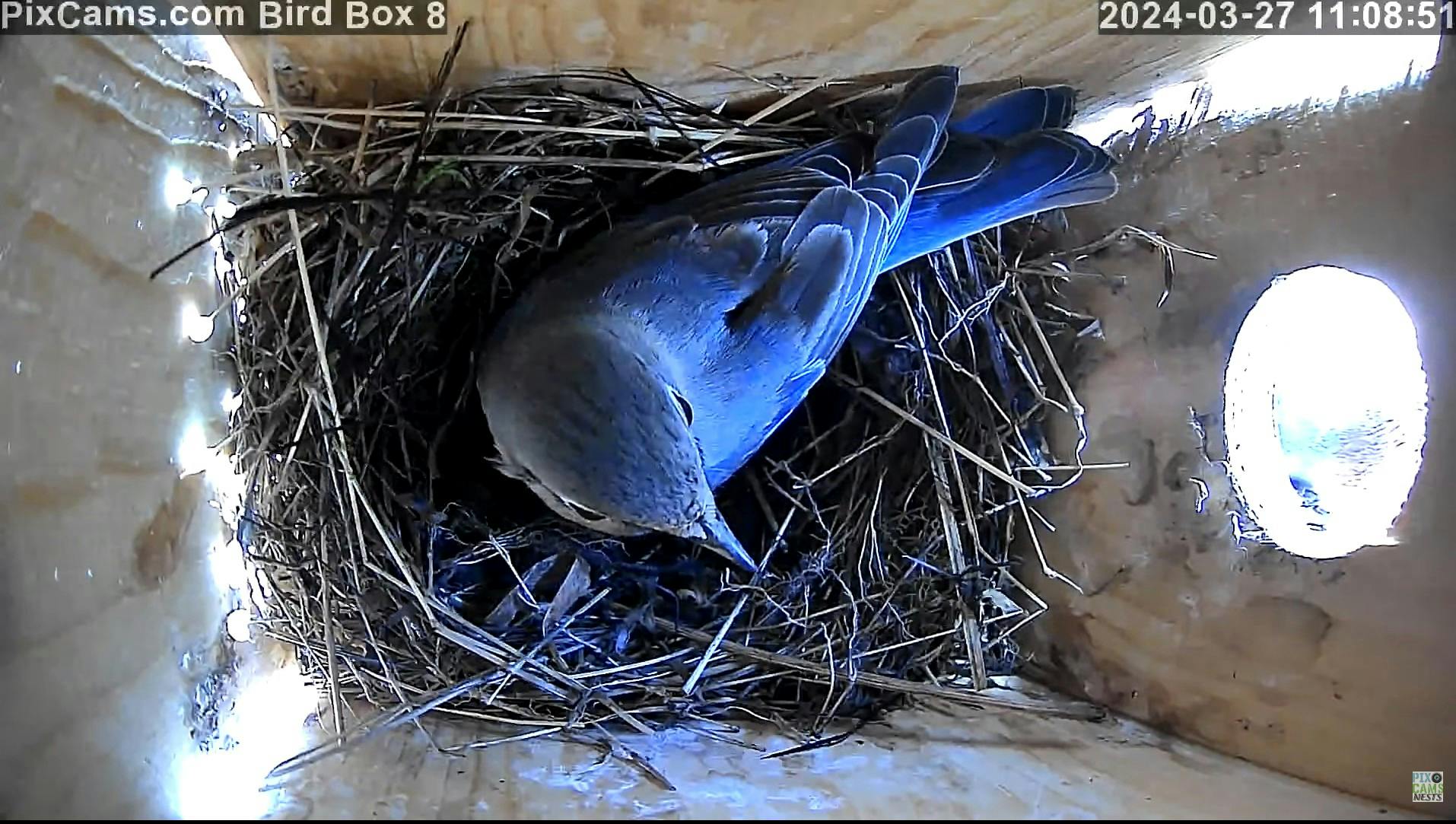Spring Nesting Season Underway
Our spring nesting season in our owl boxes and songbirds boxes at PixCams is well underway already. This is an early nesting season too. The earlier onset of spring songbird nesting season in Pennsylvania can be attributed to various environmental factors influenced by climate change. Warmer temperatures and shifting weather patterns are prompting earlier plant blooming, insect emergence, and food availability, which in turn trigger birds to start nesting earlier to synchronize with these crucial resources. Additionally, alterations in photoperiod cues may also play a role, as changing day lengths can prompt birds to initiate breeding behaviors sooner. These shifts in timing have significant implications for bird populations, as mismatches between nesting timing and peak food availability can affect reproductive success and ultimately impact species survival. Thus, understanding and addressing the drivers of these changes is vital for effective conservation efforts aimed at mitigating the effects of climate change on avian ecosystems.
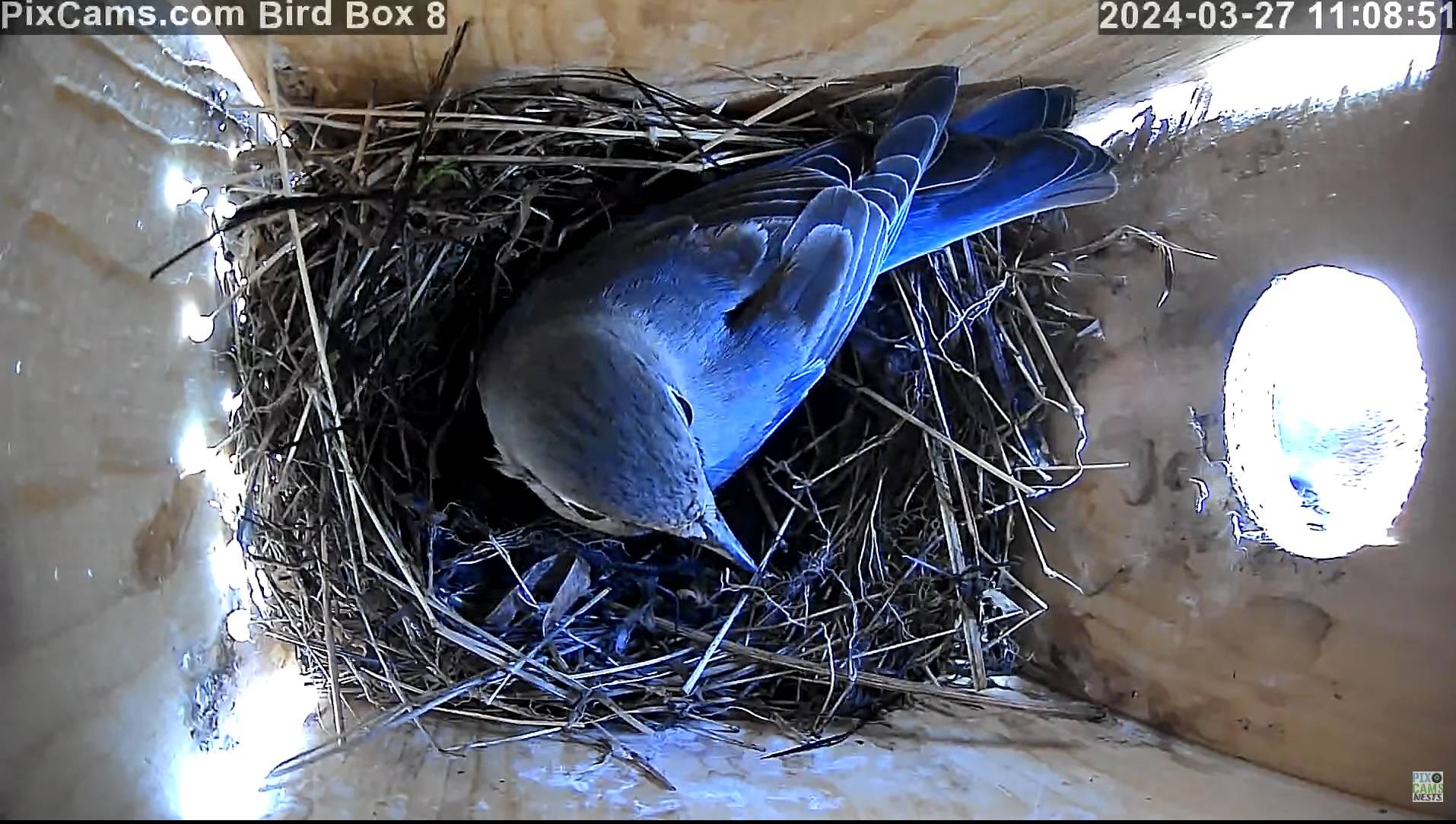 Bluebird nest started in Bird Box 8 Bluebird nest started in Bird Box 8 |
Bluebirds are Starting Nests
We have one bluebird nest almost completed in Bird Box 8. Bluebirds, known for their meticulous nest-building habits, construct their nests with great care and precision. Typically, the construction begins with the selection of a suitable nesting cavity, often a natural tree cavity or a man-made birdhouse. Once a site is chosen, the female bluebird collects nesting materials, including dry grasses, pine needles, and sometimes feathers, to form the base of the nest. She arranges these materials in a cup shape, creating a sturdy foundation. Then, she lines the cup with softer materials such as fine grasses, animal hair, or plant fibers to provide cushioning for the eggs. The nest is gradually molded into shape using the female’s body as she tamps down and shapes the materials with her bill and feet. The final result is a cozy and well-insulated nest that offers protection and warmth for the developing eggs and nestlings. The entrance hole is often lined with softer materials as well, helping to create a snug environment for the nesting birds.
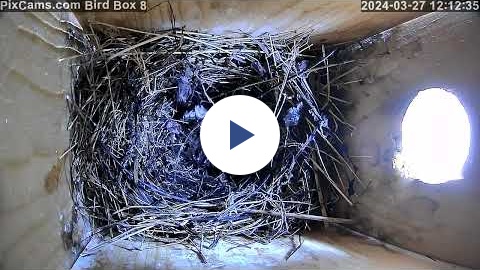
Bluebirds building nest in Bird Box 8
One of the more interesting situations is the nest building in Bird Box 5. There is a competition going on between two bluebird pairs. The nest construction started almost 3 weeks ago, but when one pair starts moving nesting material into the box the other pair throws it out and starts add their own nesting material. Needless to say there isn’t much to look at in that box yet.
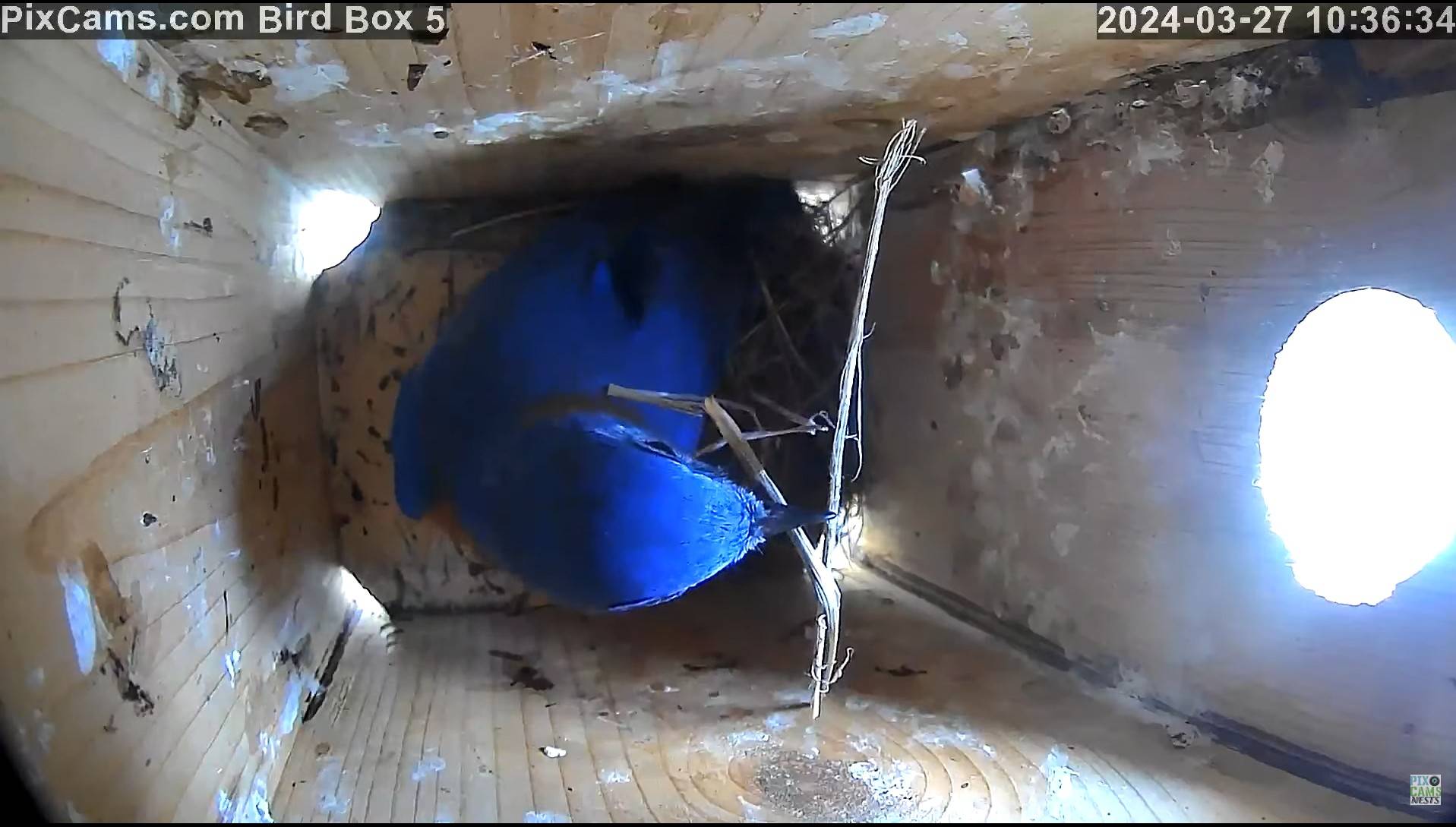 Bluebird in Bird Box 5 Bluebird in Bird Box 5 |
Bluebird Nesting Facts
- Timing: Bluebirds typically breed from March to August, with the exact timing varying depending on location and species. They may produce multiple broods in a single breeding season.
- Nest Location: Bluebirds are cavity nesters, meaning they typically nest in holes or cavities in trees. However, they readily accept man-made nest boxes, which have become crucial for their conservation, especially as natural nesting sites decline.
- Nest Construction: Female bluebirds are primarily responsible for building the nest. They construct the nest cup by layering materials such as grasses, pine needles, feathers, and other soft plant fibers. The nest is then lined with finer materials for cushioning and insulation.
- Egg Laying: Bluebirds lay one egg per day until they complete a clutch, which typically consists of 4-6 eggs. The eggs are usually pale blue or occasionally white, with some variations depending on the species.
- Incubation: After the clutch is complete, the female begins incubating the eggs, while the male assists by bringing food. Incubation lasts about 12-14 days, during which the female remains dedicated to keeping the eggs warm.
- Nestling Care: Both parents participate in feeding and caring for the nestlings once they hatch. The nestlings are altricial, meaning they are born naked and helpless and rely entirely on their parents for food and warmth.
- Fledging: Nestlings fledge (leave the nest) about 15-20 days after hatching. However, they may remain in the vicinity of the nest for several days, continuing to be fed by their parents while they learn to fly and forage on their own.
- Nest Defense: Bluebirds are fiercely territorial during the breeding season, defending their nest sites from intruders, including other bluebirds and cavity-nesting species.
- Second Broods: In favorable conditions, bluebirds may raise multiple broods in a single breeding season, especially in the southern parts of their range where the breeding season is longer.
- Nest Box Maintenance: Proper maintenance of nest boxes, including periodic cleaning and monitoring for predators and parasites, is essential for successful bluebird nesting and conservation efforts.
Two Screech Owl Nests This Season!
We had written a Blog Post back on March 3rd titled “A Chance for two Eastern Screech Owl Nests this Season!” Well this has become a reality! This is first time since we set up the owl boxes in 2011 with cameras inside that we have had two pairs of screech owl nest in our boxes.
This first pair to nest is a new pair of eastern screech owls named Violet and Griffin. Violet is a gray phase eastern screech owl and Griffin is a gray phase eastern screech owl. They laid their first egg of the season on March 19th around 5:44 PM in Owl Box 4. This is the earliest time we have ever recorded a screech owl egg in our boxes.
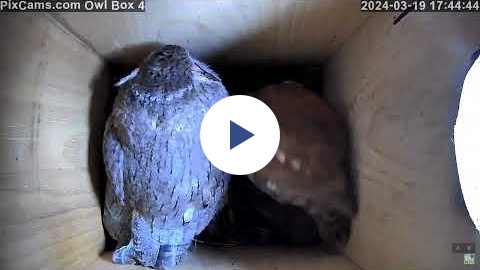
First eastern screech owl egg in Owl Box 4 on March 19th
What was odd about this first egg is the male owl, Griffin, was roosting in the box when Violet laid the egg. This is another first. We have never had the male roost in the same box when a female was nesting. This pair currently has 4 eggs!
Our second eastern screech owl nest belongs to a pair named Lala and Grayson. Lala and Grayson are both gray phase colored eastern screech owls. Lala laid her first egg in Owl Box 5 on March 22nd around 1:50 PM. This pair currently has three eggs and could have more on the way.

First eastern screech owl egg in Owl Box 5 on March 22nd
Like Violet and Griffin in Owl Box 4 Grayson was also roosting with Lala when she laid her first egg.
The night before Lala laid her first egg she got into a skirmish with Grayson over a flying squirrel in owl box 3. We have never seen this type of behavior from screech owls in the past.

Lala and Grayson fight over a flying squirrel
Could we see a Third Owl Nest?
The other strange occurrence happening in our owl boxes this year is another eastern screech owl has been consistently roosting in Owl Box 8. We have been under the assumption this is a male screech owl with a female nesting in a natural cavity close by.
 Red phase eastern screech owl roosting in Owl Box 8 Red phase eastern screech owl roosting in Owl Box 8 |
Again, this is something we have not seen in the past. Typically when we get a nesting pair of screech owls in our nest boxes we do not see any use from the other boxes.
The territory size of an Eastern Screech Owl can vary depending on factors such as habitat quality, food availability, and population density. Generally, these owls maintain territories ranging from about 10 to 50 acres in size. In areas with abundant prey and suitable nesting sites, territories may be smaller, while in areas with limited resources, territories tend to be larger. Eastern Screech Owls are cavity nesters and will defend their nesting territories vigorously against intruders, especially during the breeding season.
Our 9 owl boxes are spread over a linear distance of about 400 yards.
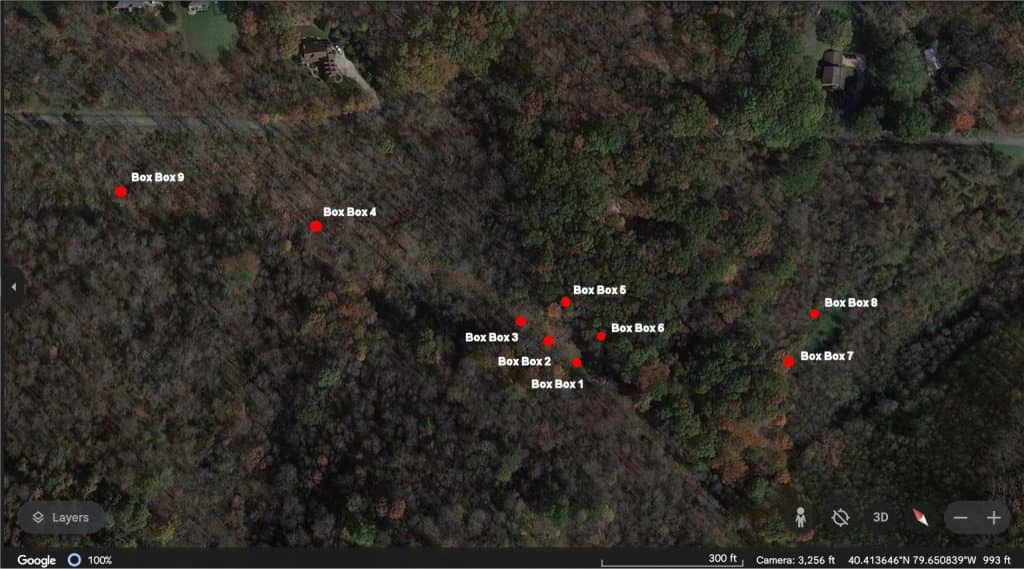 Location of the 9 PixCams Owl Boxes Location of the 9 PixCams Owl Boxes |
To give you an idea of the owl box layout see the photo above. The distance between owl box 4 and owl box 5 is about 150 yards. The distance between owl box 5 and owl box 8 is about 150 yards too. This seems like a very small area for three nesting pair of eastern screech owls to share.
Eastern Screech Owl Nesting Facts
- Nesting Sites: Eastern Screech Owls are cavity nesters, often utilizing natural tree hollows or abandoned woodpecker nests as nesting sites. They may also readily accept man-made nest boxes placed in suitable habitat.
- Nest Selection: Female Eastern Screech Owls are responsible for selecting the nesting site. They typically choose cavities located high above the ground to provide protection from predators and inclement weather.
- Nest Construction: Eastern Screech Owls do not construct nests in the traditional sense. Instead, they rely on existing materials within the chosen cavity. The female may add some soft nesting material such as shredded bark, feathers, or leaves to the cavity floor to create a soft bed for the eggs.
- Egg Laying: Eastern Screech Owls typically lay their eggs in early spring, with the exact timing varying depending on location and climate. Clutch sizes typically range from 2 to 5 eggs, with the female laying one egg every 1-2 days until the clutch is complete.
- Incubation: After the entire clutch is laid, the female begins incubating the eggs. Incubation lasts around 26-28 days, during which the female remains dedicated to keeping the eggs warm. The male assists by providing food for the female during this time.
- Nestling Care: Once the eggs hatch, both parents participate in caring for the nestlings. They feed the young owls a diet consisting mainly of insects and small vertebrates, such as mice and small birds.
- Fledging: Nestlings fledge from the nest around 4-5 weeks after hatching. However, they may continue to rely on their parents for food and protection for several weeks after leaving the nest as they learn to hunt and become independent.
- Territoriality: Eastern Screech Owls defend their nesting territories vigorously against intruders, including other owls and predators. They may vocalize or engage in aggressive displays to deter intruders from approaching their nest site.
- Conservation: Maintaining suitable habitat and providing nest boxes can help support Eastern Screech Owl populations, especially in areas where natural nesting sites are scarce due to habitat loss or urbanization. Monitoring and conserving nesting sites are essential for the long-term survival of these fascinating birds.
Bonus Nest: Flying Squirrel!
Along with our other firsts this year we also have a Southern Flying Squirrel nesting in Bird Box 9. The flying squirrel started constructing a nest on March 8th. The nest now is a bowl with a roof over top so it’s hard to see what’s going on.
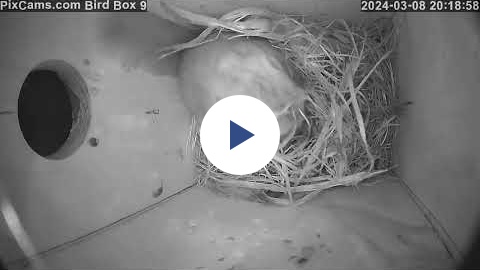
The southern flying squirrel is a fascinating nocturnal mammal found across much of Pennsylvania. Despite their name, they do not truly fly but rather glide using a patagium, a flap of skin that extends between their fore and hind limbs. These squirrels are small and arboreal, spending much of their time in trees where they nest in tree cavities or leaf nests. They are highly social animals, often living in colonies or family groups. Their diet primarily consists of nuts, seeds, fruits, insects, and occasionally bird eggs. Southern flying squirrels are excellent gliders, capable of traveling distances of up to 150 feet (45 meters) between trees. They are important members of their ecosystems, aiding in seed dispersal and serving as prey for predators such as owls and snakes. Despite their widespread distribution, southern flying squirrels are primarily nocturnal and secretive, making them less commonly seen than their diurnal counterparts.
Could we see a nest with babies? Come watch!
Southern Flying Squirrel Nesting Facts
Southern flying squirrels exhibit interesting nesting behaviors that are adapted to their nocturnal and arboreal lifestyle:
- Nest Sites: Southern flying squirrels nest in tree cavities, bird nests, or abandoned woodpecker holes. They may also construct nests out of leaves, twigs, and other materials in tree branches or cavities. These nests provide protection from predators and harsh weather conditions.
- Social Nesting: Southern flying squirrels are social animals and often nest in communal groups, particularly during the colder months when they huddle together for warmth. These groups can consist of several individuals, typically related family members or individuals from the same colony.
- Breeding Nests: Breeding nests are typically established by a female flying squirrel in preparation for giving birth and raising young. The female lines the nest with softer materials such as moss, leaves, and fur to create a cozy and insulated environment for her offspring.
- Multiple Nests: Southern flying squirrels may use multiple nests within their home range, moving between them periodically. This behavior helps them avoid predators and take advantage of seasonal food resources.
- Nocturnal Activity: Since southern flying squirrels are nocturnal, their nesting activities primarily occur at night. They venture out from their nests under the cover of darkness to forage for food and socialize with other members of their colony.
- Growth of Young: After birth, the young remain in the nest for several weeks, cared for by the mother. During this time, the female flying squirrel provides warmth, protection, and nourishment until the young are ready to venture out on their own.
- Conservation of Nesting Sites: Protecting and preserving mature forests with suitable nesting habitat is crucial for the survival of southern flying squirrels. Maintaining a variety of tree species and cavity structures ensures the availability of nesting sites for these fascinating nocturnal mammals.
